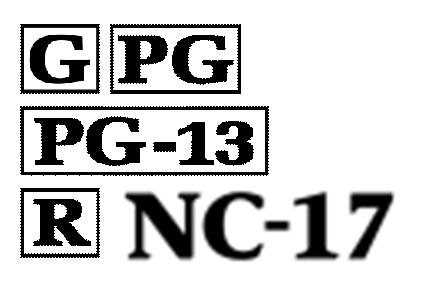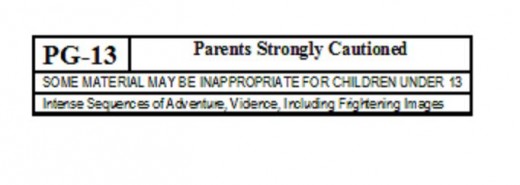Rated G for General Audiences

By Joan Whetzel
Going to the movies is fun. Something about sitting in the dark, with a bunch of strangers who are all there to enjoy the same show, all laughing or being scared or surprised at the same parts of the movies, enhances the experience. Plus, there's the added attraction of seeing it on the silver screen, in larger-than-life action that makes the whole story-telling experience, well, larger-than life. But it has become obvious over the century or so that movies have become a part of our collective entertainment experience, that not all movies are appropriate for all audiences. That's where the Movie Rating System comes in.
Movie Rating System in the US
The movie rating system in the US began in the 1960s, as the studio control of movies deteriorated, and the content of the movies started becoming more provocative - adding language, increasing degrees of nudity, and increasing degrees and amounts of violence. The Motion Picture Association of America (MPAA) came into existence to answer the concerns of parents who needed to have some idea of what to expect in a movie before taking their children to the theater. The MPAA developed a basic movie rating system that has evolved into the rating that now exists in the US.
Why Rate the Movies?
Movies are rated according to its thematic and content suitability for specific audiences. Each movie is evaluated for language (use of words not suitable for young audiences), showing drugs or drug use, depiction of cigarette smoking, degree and amount of violence, and the amount and degree of nudity or sexual content. Walt Disney Pictures does not allow cigarette smoking to be depicted in any of its newer films. Obviously some of its older films, like "101 Dalmatians" had characters that smoked, which caused problems with parents concerned that it would be teaching their children to smoke, hence rthe PG-13 rating rather than Disney's regular G or PG ratings. Parents have been and continue to be, the driving force behind the rating system, which over recent years, has been widened to include TV programming and video games.
The Movie Ratings, and What the Ratings Mean
The current rating system provided by the MPAA includes the following ratings: G, PG, PG-13, R, NC-17, and X. Each of these ratings has specific criteria that causes a film to be listed that category. At the beginning of the film, and at the bottom of all movie posters, is a bar that provides the rating information for that the movie, that looks something like this.

The movie's rating (G, PG, PG-13, R, NC-17) is listed in the top left corner. Directly to the right is a statement that indicates the degree of caution that parents should take into account when deciding whether the movie is suitable for their children. In the middle of the bar, directly under the rating, is a statement about which audience level this movie may be inappropriate for. The bottom line identifies the qualifiers or reasons that this film has been given its rating.
· G Ratings - General Audiences: "All ages are admitted" to these movies. The theme or story line of these movies contain nothing that sensitive young children should be subjected to. The films contain no offensive language, no nudity or sexual content, no drugs or cigarettes (at least in current films), and no violence. Though the G rating is always applied to children's movies, not all G rated movies are classified as children's movies. There are plenty of documentaries and nature films, as well as family oriented films that carry a G rating.
· PG - Parental Guidance Suggested: "Some Material May Not Be Suitable for Children." This rating suggests that parents find out about the movie before deciding whether to allow their younger children to attend, especially if those younger children are quite sensitive or easily suggestible. This rating indicates that there may be some foul language and some portrayals of violence or of brief nudity somewhere in the movie. The language, nudity, or violence is usually brief and deemed to be of low intensity or of minor degree. No drugs or drug use is portrayed in a PG rated movie.
· PG-13 - Parents Strongly Cautioned: "Some Material May Be Inappropriate for Children Under 13." The PG-13 warning is stronger than the PG warning, suggesting that the of the film contains scenes or situations that are not recommended for children under the age of 13, and that the parents should find out what they can before deciding whether to let their children of any age attend the film. PG-13 films contain either longer sequences of or a stronger degree of violence, nudity or sensuality (not sexual suggestive action), language, some adult activities or thematic and storyline elements that may be difficult for younger children to digest. The scenes depicting violence in PG-13 films are not generally both realistic and extreme or persistent.
· R - Restricted: ”Under 17 Requires Accompanying Parent or Adult Guardian." These films contain some adult material and, so, are not recommended for children under the age of 17. R-rated films may contain, adult themes or storylines, adult activity, hard language (more than just a few foul words), violence that is persistent and intense, a higher degree of nudity which is sexually-oriented in nature, and depictions of drugs and drug use. The MPAA strongly suggests that parents take this rating seriously before permitting their children to watch these films.
· NC-17 - No One 17 and Under Admitted: NC-17 films have much stronger content than the typical R-rated movies, but not as strong as an X-rated film. Theaters are not allowed to sell tickets to anyone aged 17 or younger or to admit ticket holder aged 17 or younger into the theater showing an NC-17 film. Theaters are even willing to post personnel at the door of a NC-17 film to prevent anyone under the age of 18 from even entering that theater. If it appears that an adult has purchased a ticket for someone under the age of 18, the young patron will be turned away at the door or at the ticket taker's stand. The theater may even hold the child and call the child's parents to come pick them up, so that it may be explained that the theater cannot legally admit a child to this film. Language in these films reaches the level that most adults would define as obscene. Sexual and nude scenes reach the level of pornographic depictions, though there is less nudity and sexual scenes than in an X-rated film. NC-17 Films contain content appropriate for adult audiences which may include strong violence, sex, aberrant behavior, drug abuse and any other behavior that parents would consider too intense and convincing, and should be considered off-limits for their children's viewing.
Resources
Wikipedia: Motion Picture Association of America Film Rating System.
http://en.wikipedia.org/wiki/Motion_Picture_Association_of_America_film_rating_system
Motion Picture Association of America. Film Ratings.






